Overview
The 6th Annual International Thymic Malignancy Interest Group (ITMIG) Meeting in Shanghai on Oct 23–25 was a resounding success. It was marked by exciting sessions, scientific progress and further development of relationships and collaborations among clinicians, researchers and our industry partners. Thanks to Dr. Wentao Fang and his international program committee, this year’s meeting hit a new record in terms of attendance (241 participants), coming from 20 countries and all major specialties. The atmosphere was marked by enthusiasm, engagement and the open friendly collaboration that characterizes ITMIG events (Figure 1).
Figure 1.
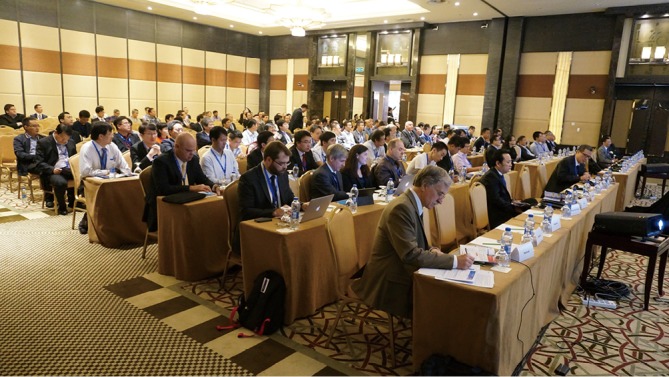
The atmosphere was marked by enthusiastic engagement of clinicians and researchers worldwide.
The conference began with a series of productive committee meetings (Figure 2). The 2-day scientific portion of the meeting consisted of a blend of invited speakers organized around particular themes, 16 oral abstracts and 40 posters selected as the best of the submitted abstracts. There were also two special “innovative lectures” in keeping with the ITMIG tradition of thinking outside the box in order to find novel ways to advance in a rare disease (Figure 3). The full program and abstracts can be viewed on the ITMIG website (www.itmig.org), and are shown here in this supplementary issue of Journal of Thoracic Diseases.
Figure 2.
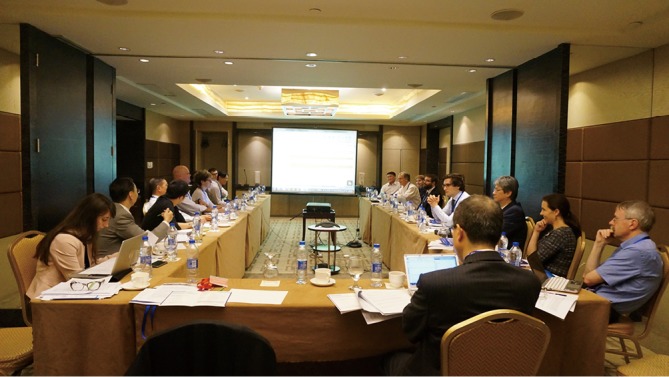
Committee meeting.
Figure 3.
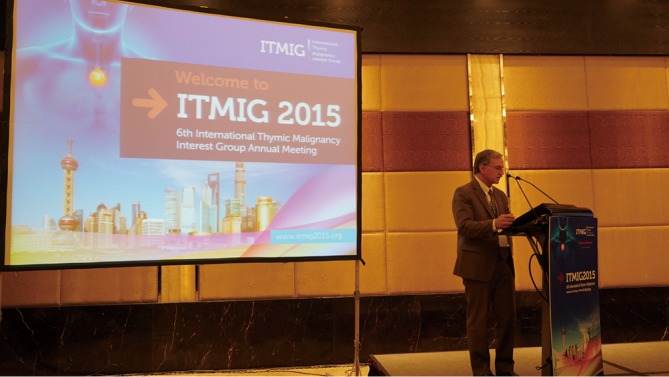
Prof. Detterbeck was giving an innovative lecture on outlier analysis.
Scientific sessions
Although the whole meeting was excellent, a few things deserve mention as being new areas of accomplishment for ITMIG. First of all, the engagement and contributions of the many people and institutions in China interested in thymic malignancies was impressive. The Chinese Association for Research in Thymomas (ChART) organization presented several studies from their large database, which has been merged with the ITMIG database. This was supplemented by other studies from Japan and South Korea in a great “Asian Session” that started the meeting.
Another highlight was a review of the projects made possible by the ITMIG databases. This included completed (and published) studies, projects nearing completion, ongoing studies, as well as the upgrades that have been made to the retro- and prospective databases. In particular, Dr. Robert Korst, current Chairman of the ITMIG, provided insight into the power of the HUBzero platform for the prospective database (Figure 4). This session emphasized how the collaborative efforts of the ITMIG community have produced a tremendous resource for progress, and underscored the value of the foundation that has been built in the prospective database if the same global engagement could be continued. Early results of the first project involving the prospective database were presented.
Figure 4.
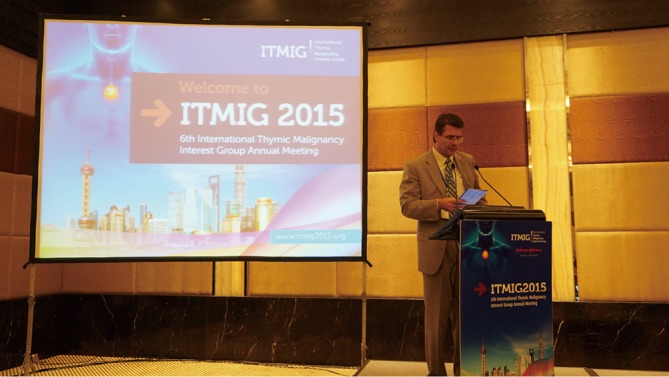
Prof. Korst provided insight into the power of the HUBzero platform for the prospective database.
A new development in ITMIG—branching out more broadly to address promoting science in the management of mediastinal tumors in general—was the focus of the “Mediastinal Session”. This included an educational case-based discussion as well as the results of initial projects of the mediastinal workgroup, led by Dr. Anja Roden. While there are significant challenges, the need is there, and the session made it clear that ITMIG is beginning to make progress in this broader arena.
The launch of the ITMIG virtual tumor board certainly stood out as an exciting session. Led by Drs. Benny Weksler, Jose Arenas and Sara de Cabanyes, a platform has been developed that allows radiologic and microscopic images to be uploaded with monthly case discussion by a multidisciplinary panel of international experts. The session demonstrated the process by discussing multiple cases that had been brought by participants. The discussion and resulting recommendations were educational for all and left no doubt about the value of such expert discussion. This marks an exciting new resource for the global community that is provided by the ITMIG infrastructure and the dedication of all involved to do whatever they can to improve patient outcomes.
The oral abstract sessions this year were focused on Molecular Biology and Chemotherapy, Novel Treatment Approaches, Epidemiology/Regional Trends and Patient Evaluation. Other scientific sessions included a focus on clinical research activities and minimally invasive approaches to resection. This included an innovative lecture on ethical and practical issues associated with developing and implementing novel approaches—issues which are magnified in a rare disease. This was given by Dr. Kurt Roberts, who is a pioneer in the development of Natural Orifice Transluminal Endoscopic Surgery (NOTES) procedures.
The meeting finished with an exciting glimpse into the future. The last session was devoted to basic science advances, which included new insights and practical guidance on how to build a tumor bank resource. The final talk was given by the overall head of the Cancer Genome Atlas (TCGA) project, Dr. JC Zenklusen. This was an invigorating and entertaining lecture, which provided an overview of the astounding level of sophisticated analysis that is part of the TCGA system and how powerful this investigation can be in understanding the fundamental biology. It underscored how uniquely important it is that the ITMIG community was able to mobilize and participate in the TCGA project. The results of the thymic analysis are still under embargo, but the attendants received a tantalizing glimpse that it promises to be a huge leap forward.
Industry collaboration
The meeting provided an open, inclusive forum for discussion and networking between clinicians and industries that are also committed to improving patient outcomes. The activity in the exhibit hall and in various spontaneous meetings in the foyer demonstrated the value of this atmosphere that is a cornerstone of the ITMIG meetings. Besides the social, scientific and clinical connections that ensue, the annual ITMIG meeting would not be possible without the generous support of our industry partners. These included Medtronic and Johnson & Johnson (platinum sponsors), Medela (gold sponsor) as well as BD, Rultract, Scanlan and AME Publishing Company. In addition to the informal discussions, there were three well-attended sponsored educational sessions: The Use of Ultrasonic Energy (Johnson and Johnson), Challenging VATS (Medtronic) and Streamlining Thoracic Surgical Care (Medela).
Prizes and social events
This year, the Barbara Niebauer award for the best thymic carcinoma abstract went to Dr. Changlu Wang for “S-1 Salvage Treatment for Chemorefractory Stage IV Thymic Carcinoma”, the Juan Rosai award for the best poster to Dr. Kris Rohrberg for “Comparing Radiotherapy with Free Breathing and Deep Inspiration Breath Hold for Thymic Cancers”, and the Akira Masaoka award to Dr. In Kyu Park for “The Extent of Lymph Node Dissection in Thymic Malignancies”.
The ITMIG meeting also offered an opportunity to visit the exciting city of Shanghai—certainly an experience for those who had not previously had the opportunity. In addition, there was an opportunity after the meeting to visit the Shanghai Chest Hospital, which is the largest thoracic oncology center in China, and sees over 10,000 lung cancers, 1,000 esophageal cancers and 1,000 mediastinal lesions every year. The Shanghai Chest Hospital played a major role in facilitating the 2015 ITMIG meeting.
Next year in San Francisco
Planning is well underway for the ITMIG 2016 meeting, which will take place in San Francisco in September 2016 (Figure 5). Drs. Heather Wakelee and Joe Shrager are the program chairs. It was impressive at the 2015 meeting to see what has been accomplished through the efforts of ITMIG members in 5 years. Given this momentum and all the active initiatives, further advances are eagerly anticipated to be shared in 2016. Hope to see you next year in San Francisco!
Figure 5.
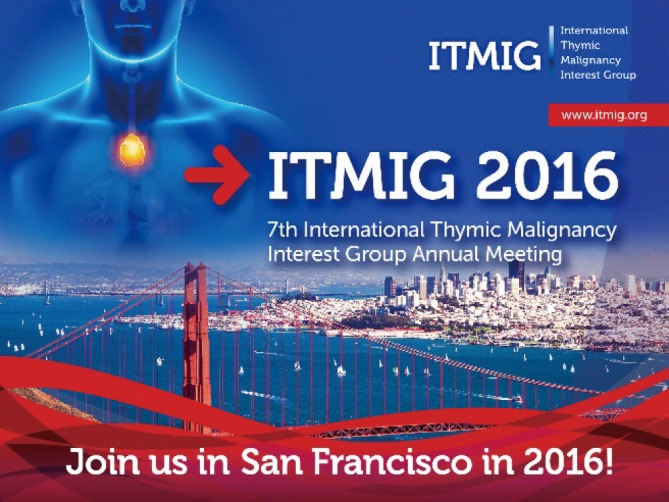
ITMIG 2016 meeting will take place in San Francisco.
Acknowledgements
None.
Footnotes
Conflicts of Interest: The author has no conflicts of interest to declare.


